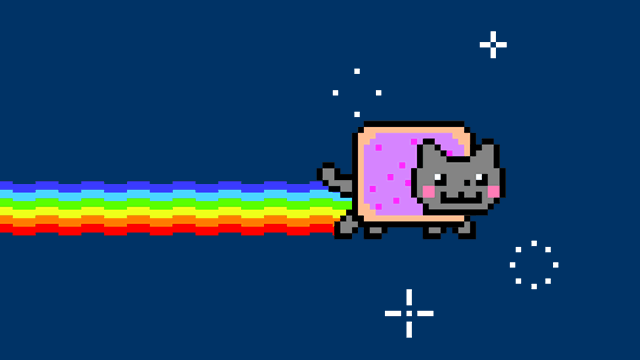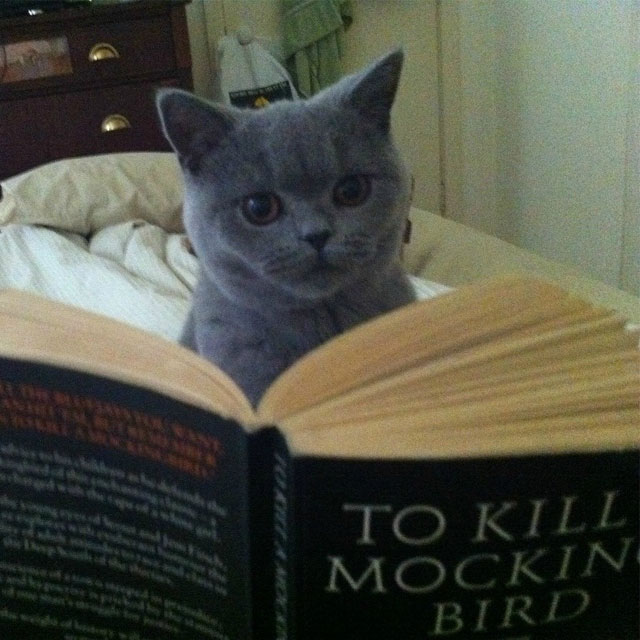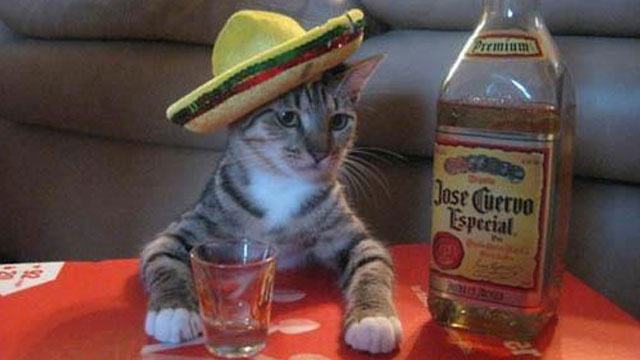You’ve seen them flying through space on a rainbow, running for mayor and being grumpy; cats are everywhere on the internet to the point that America’s favorite pet has reached a totemic status on the web and have cat-centric holidays dedicated to their online worship.
 Nyan Cat is one of the most famous internet memes which combines an animated cartoon cat with a Japanese pop song.
Nyan Cat is one of the most famous internet memes which combines an animated cartoon cat with a Japanese pop song.
 Morris was a mayoral hopeful in Mexico who promised to eat, sleep most of the day and donate his leftover litter to fill potholes.
Morris was a mayoral hopeful in Mexico who promised to eat, sleep most of the day and donate his leftover litter to fill potholes.
 Grumpy Cat has generated over a $100 million in revenue through endorsements and personal appearances.
Grumpy Cat has generated over a $100 million in revenue through endorsements and personal appearances.
The lolcats use the interwebz to take over traditional media
In his autobriography “I Sold Sex, Drugs, & Rock ‘n’ Roll”, Art Director extraordinaire, Mike Salisbusy bluntly states that to create a successful ad campaign you need either a pet or a baby. So it is quite natural that agencies have jumped on the catrain and decided to utilize our fascination for our feline friends to sell their wares.
It is to be noted that cat-powered content is shared among all marketing segments conceivable; even dog lovers!
#CatsWithThumbs was a UK campaign created to promote Cravendale, a milk company. Thanks to its polydactyl cats, the ad achieved global success online, garnering millions of views.
Folksam, the Swedish insurance company, produced a very successful ad featuring “real footage” of skydiving cats that sparked online outrage, yet no cat has ever left the cozy film studio.
Cats have always been used in advertising, but their current overwhelming presence in advertising is deeply rooted in their dominance of the internet. Where advertising and marketing always relied on witty messaging and inflating claims, the audience has always seen it as fake whereas image macros of cats with humorous puns still carry a certain authenticity.
It is expected for a cat photo to become a meme, to have grammatical errors, and an absurd sense of humor; those traits define lolcats.
 Funny photos are the basis of lolcat memes; juxtaposing the subjects with idiosyncratic and grammatically incorrect text.
Funny photos are the basis of lolcat memes; juxtaposing the subjects with idiosyncratic and grammatically incorrect text.
 Breaking the rules of the medium, grammar and reality is what has allowed lolcats to gain huge popularity very quickly.
Breaking the rules of the medium, grammar and reality is what has allowed lolcats to gain huge popularity very quickly.
 Business Cat is one of these image macros that has achieved enough fandom to have been given a proper name.
Business Cat is one of these image macros that has achieved enough fandom to have been given a proper name.
From B2B to B2C, Catvertising is Purrfect
Since cats have invaded our mediaspace and their likability doesn’t seem to be altered by time, catvertising is here to stay and for very good reasons: if done properly a campaign utilizing cat and humor doesn’t rely on a dated event or phenomenon as a basis for its humor, therefore, even if some of the references might be dated, what makes the campaign popular in the first place is still relevant.
One more thing that shouldn’t be discounted is the influence of cats on humans: from being quirky animals every one would like to cuddle with to being devious overlords using brain parasites to control mankind’s moods, cats have a hold of us and are able to communicate and influence us in a very insidious manner.
Catvertising is a fantastic promotional video for a Canadian ad agency. John St. harnessed the internet’s insatiable fondness for cat videos to reach the attention of potential clients.
Catnip infused cards were mailed to herald the benefits of a certain brand of cat litter; undoubtedly many cat owners wondered why their furry companions were attracted to these cards.
It is very common to see a cyclical pattern when observing catvertising campaigns: upon release an ad would be shared quite extensively, then go into a sort of dormant phase until it reaches a new social group and jump in popularity once more. If marketing campaigns can be seen as one big wave, catvertising campaigns are more similar to earthquakes, as aftershocks are difficult to predict despite knowing the certainty of their occurrence.
 Anthropomorphism allows cats to be put in any situation that, if portrayed by humans, would be stereotypical and offensive.
Anthropomorphism allows cats to be put in any situation that, if portrayed by humans, would be stereotypical and offensive.
 Animated GIFs used to be a medium associated with spam advertising, until people started to use them to feature cats.
Animated GIFs used to be a medium associated with spam advertising, until people started to use them to feature cats.
 The catweb is the growing corner of the internet were cats are worshipped; caturday is a weekly observance dedicated to cats.
The catweb is the growing corner of the internet were cats are worshipped; caturday is a weekly observance dedicated to cats.
I Can Haz Content Marketing?
All the reasons mentioned above are aiming in the direction of content marketing: production of quality content has a heavy cost attached to it and its return on investment is function of how long can the created content be relevant and shared; in this case both arguments have a longevity that is hard to match because the focus is shifted to cats.
If you take the Superbowl as an example, where a lot of brands try to produce content which focuses on the game itself and the teams involved, whereas a cat focused piece would utilize the game as a setting making any dating element like teams irrelevant.
Catastrophes is a highly shared comedy series created by, and promoting the Tree House. The Chicago animal shelter saw a significant increase in donations from patrons outside of Illinois.
Dear Kitten is native advertising produced by BuzzFeed. The series give its sponsors, Purina/Friskies, the opportunity to be associated with seasonal events that do not directly relate to their products.


